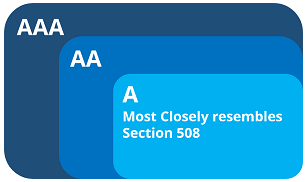6 A Shift Toward Broader Standards and Functionality Supporting Accessible Online Content
Heather Caprette
Legislation regarding accessibility at higher educational institutions recently changed. In the United States, we follow Section 508 guidelines for designing websites and online content. The U.S. Access Board writes Section 508 rules for organizations receiving federal funds to follow, as part of the 1998 Amendment to the Rehabilitation Act. They are enforced by the Dept. of Education’s Office of Civil Rights and the Department of Justice.
Section 508 rules were previously published on December 21, 2000, and implemented in the summer of 2001. However, Section 508 recently underwent a refresh, and the new standards were written into the Federal Registrar on January 18, 2017. The new standards align with the Web Content Accessibility Guidelines 2.0 (WCAG 2.0) Level AA. At the time of writing, WCAG went through an update to version 2.1 on June 5th, 2018 and will soon update to WCAG 2.2 later in 2022. We’ll have to keep checking to see when Section 508 points to the newer standards. The Web Content Accessibility Guidelines are written by the Web Accessibility Initiative (WAI) at the World Wide Web Consortium. This is an international group and these are international standards that have been adopted by designers in other countries, such as in Europe and Canada, already. There are three levels to each WCAG 2.0 guideline – Level A is what you must do, level AA is what you should do, and level AAA produces the best accessibility for the most people. The WCAG 2.0 guidelines are broader in scope than the previous Section 508 standards. The new focus will be on functionality rather than device or technology specific standards. Technology has changed a great deal since Section 508 standards were last written in 2000. People are no longer relying on desktops primarily to access information. They are using smart phones and other mobile devices with voice text and video communications. By harmonizing U.S. standards with what other countries are following, we will create a larger market for our information and communication technology. Along with the Section 508 rules rewrite, section 255 of the Communications Act of 1934 is also being updated. Section 255 applies to the manufacturers and authors of our communication and information technology devices and software. The information and communication technology the new standards refer to are: VOIP products, computers, software, office machines, information kiosks, transaction machines, websites, and electronic documents.
The image below shows the degree of accessibility each level of WCAG 2.0 covers compared to the previous Section 508 standards, which most closely resembles WCAG 2.0 Level A.

Another change to Section 508 is delineation of covered “content.” All public facing content as well as eight categories of non-public facing content will have to be accessible.

